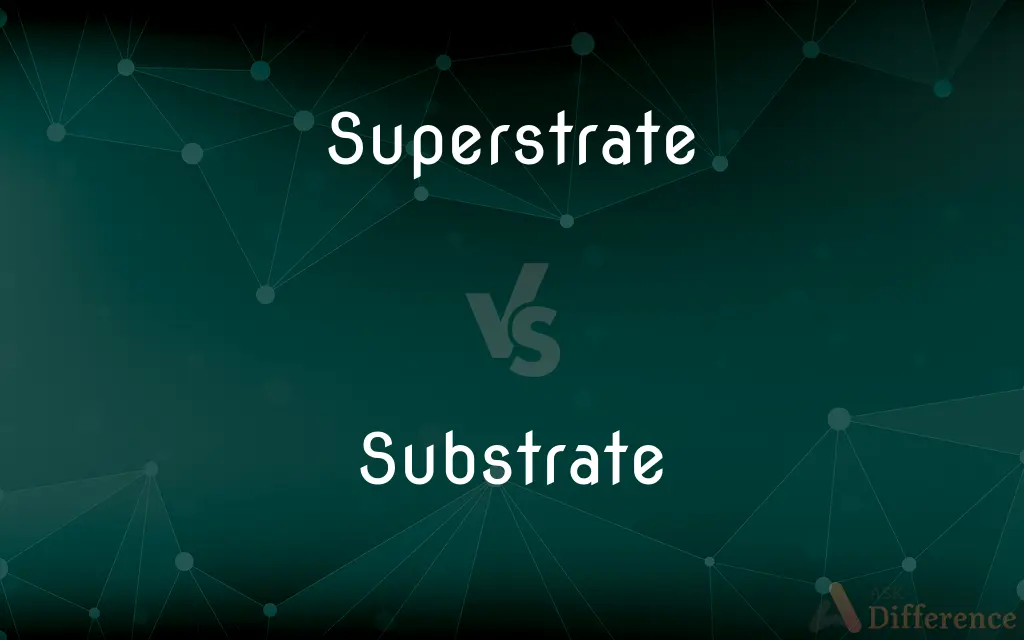Superstrate vs. Substrate — What's the Difference?
By Maham Liaqat & Urooj Arif — Updated on April 16, 2024
Superstrate languages influence a region's dominant language, usually after conquest, while substrates are indigenous languages that influence an incoming language.

Difference Between Superstrate and Substrate
Table of Contents
ADVERTISEMENT
Key Differences
Superstrate languages are typically those brought by conquerors or culturally dominant groups and may significantly influence the local language's vocabulary and structure. Whereas substrates are original languages of a region that get absorbed or altered due to the dominance of superstrate languages.
Superstrates often have a lasting impact on the syntax and lexicon of the local languages, particularly in regions with historical invasions. On the other hand, substrate languages can leave remnants in the form of regional dialects or accents, subtly persisting despite the prevalence of the superstrate.
In linguistic evolution, superstrates are generally associated with higher socio-political power, shaping the language of administration and elite discourse. Substrates, however, are linked to the lower socio-economic strata and might only be evident in informal communication or rural areas.
The influence of superstrate languages is usually more visible and can be seen in the widespread adoption of loanwords and grammatical structures. Conversely, the influence of substrates is often less obvious and may require detailed linguistic analysis to detect.
Superstrate and substrate languages highlight the dynamics of linguistic change following social upheaval, migration, or conquest, where superstrates typically represent the 'imposer' and substrates the 'imposed upon'.
ADVERTISEMENT
Comparison Chart
Definition
Language of a dominant or ruling group
Indigenous language influenced by another
Influence on Region
Imposes features on local language
Underlying influence on new dominant language
Socio-political Role
Often linked to higher social classes
Associated with lower social classes
Visibility
Highly visible in public and formal use
Mainly visible in informal settings
Examples
English in India, French in West Africa
Gaelic in Scotland, Etruscan in Italy
Compare with Definitions
Superstrate
A language that has dominated and influenced another after being introduced.
English served as a superstrate in India, significantly influencing local languages.
Substrate
The original language of an area, affected by the introduction of a superstrate.
Various Indian dialects serve as substrates influenced by English.
Superstrate
The language of a more powerful or colonizing population.
French acted as a superstrate in many African countries during the colonial period.
Substrate
A language that provides a base layer in the presence of a dominating language.
Sumerian was a substrate under the Akkadian superstrate.
Superstrate
Any language that imposes itself and alters another.
Latin was a superstrate that affected many European languages.
Substrate
Refers to a linguistic layer that is less dominant.
The Celtic languages are substrates under the English superstrate in the British Isles.
Superstrate
Language from an upper social stratum.
Mandarin is considered a superstrate in various Chinese dialects.
Substrate
Language from a lower social stratum influencing another.
Basque has acted as a substrate for Spanish in certain linguistic aspects.
Superstrate
Refers to a linguistic layer that is more dominant.
Dutch was the superstrate in parts of Indonesia.
Substrate
A less dominant language influencing a dominant one, often subtly.
The influence of Native American languages as substrates is evident in some regional American English.
Superstrate
The language of a later, invading people imposed on and leaving features in an indigenous language.
Substrate
The material or substance on which an enzyme acts.
Superstrate
A layer or stratum adjacent and parallel to another.
Substrate
(Biology) A surface on which an organism grows or is attached.
Superstrate
(physics) The sudden increase in the electrical conductivity of some metals as their temperature falls to near absolute zero.
Substrate
An underlying layer; a substratum.
Superstrate
(photovoltaics) The covering on the sunny side of a photovoltaic (PV) module, providing protection for the PV materials from impact and environmental degradation while allowing maximum transmission of the appropriate wavelengths of the solar spectrum.
Substrate
(Linguistics) An indigenous language that contributes features to the language of an invading people who impose their language on the indigenous population.
Superstrate
(linguistics) superstratum
Substrate
An underlying layer; a substratum.
Superstrate
To arrange in parallel layers or strata.
Substrate
The substance lining the bottom edge of an enclosure.
The substrate of an aquarium can affect the water's acidity.
Stream substrate affects fish longevity.
Substrate
(biochemistry) A substance acted upon, as by an enzyme.
Substrate
(biology) A surface on which an organism grows, or to which an organism or an item is attached.
The rock surface of a rockpool is the substrate for a sessile organism such as a limpet.
Substrate
(linguistics) A language that is replaced in a population by another language and that influences the language imposed on its speakers.
Substrate
(plating) A metal which is plated with another metal which has different physical properties.
Substrate
(construction) A surface to which a substance adheres.
Substrate
To strew or lay under.
Substrate
Having very slight furrows.
Substrate
A substratum.
Substrate
Having very slight furrows.
Substrate
To strew or lay under anything.
The melted glass being supported by the substrated sand.
Substrate
The substance acted upon by an enzyme or ferment
Substrate
Any stratum lying underneath another
Common Curiosities
How does a superstrate differ from a substrate in terms of influence?
Superstrates have a direct and often substantial influence, altering vocabulary and syntax, whereas substrates have a subtle, often less visible impact.
How do linguists identify substrates in a language?
Linguists look for persistent linguistic features that differ from those typical in the dominant language, often requiring historical and comparative linguistic analysis.
Can you give an example of a substrate language and its impact?
Gaelic in Scotland serves as a substrate, influencing Scottish English pronunciation and contributing local terms.
Can you give an example of a superstrate language and its impact?
English in India is an example of a superstrate, where it has introduced new vocabulary and become a language of administration and higher education.
What is a substrate language?
A substrate language is an indigenous language that has been influenced by a dominant incoming language but still affects it in subtle ways.
Why are superstrate languages often associated with power?
They are typically languages of conquerors, colonizers, or economically dominant groups.
What historical conditions typically lead to the development of superstrate and substrate languages?
Conquests, colonization, migration, and trade can all lead to such linguistic developments.
What is a superstrate language?
A superstrate language is the language of a dominant or ruling group that influences another language after its introduction.
How do superstrates and substrates affect linguistic diversity?
They contribute to linguistic diversity by blending features of multiple languages, creating unique dialects and linguistic features.
What are some common features introduced by superstrate languages?
Common features include loanwords, new syntactic structures, and sometimes new phonetic features.
What role do substrates play in the preservation of cultural identity?
They help maintain cultural heritage and identity through language, despite the dominance of superstrate languages.
Is the influence of substrate languages always diminishing?
Not necessarily; substrate influence can persist or even resurge as cultural values shift.
Can the roles of superstrate and substrate reverse over time?
Yes, changing socio-political dynamics can lead to a substrate language gaining dominance and becoming a superstrate.
What are some examples of substrate influence that are not immediately obvious?
Subtle phonetic or grammatical influences in a region’s dominant language may stem from substrates.
How do superstrate and substrate languages coexist in a bilingual society?
They often coexist with varying degrees of bilingualism, where speakers switch between using features of both in different contexts.
Share Your Discovery

Previous Comparison
Scope vs. Span
Next Comparison
Emerging vs. NascentAuthor Spotlight
Written by
Maham LiaqatCo-written by
Urooj ArifUrooj is a skilled content writer at Ask Difference, known for her exceptional ability to simplify complex topics into engaging and informative content. With a passion for research and a flair for clear, concise writing, she consistently delivers articles that resonate with our diverse audience.














































